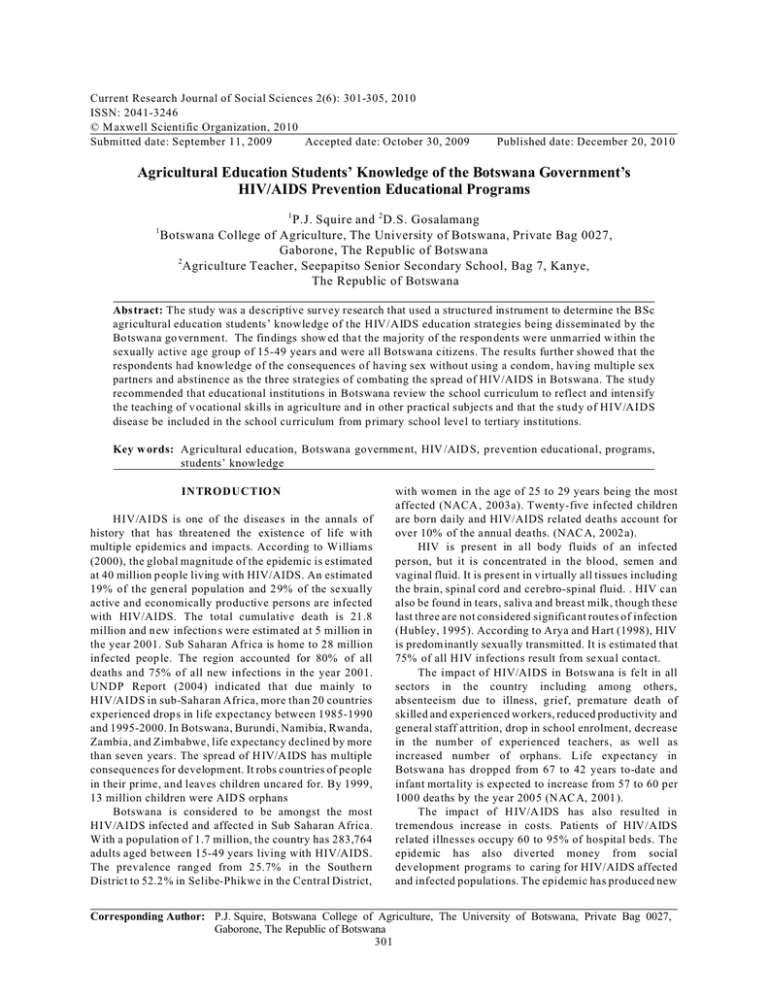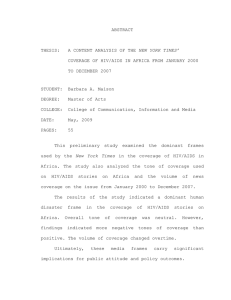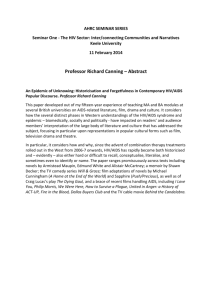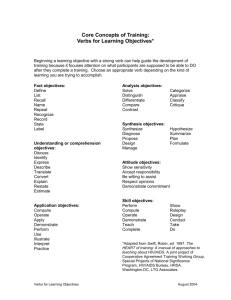
Current Research Journal of Social Sciences 2(6): 301-305, 2010
ISSN: 2041-3246
© M axwell Scientific Organization, 2010
Submitted date: September 11, 2009
Accepted date: October 30, 2009
Published date: December 20, 2010
Agricultural Education Students’ Knowledge of the Botswana Government’s
HIV/AIDS Prevention Educational Programs
1
1
P.J. Squire and 2 D.S. Gosalamang
Botswana College of Agriculture, The University of Botswana, Private Bag 0027,
Gaborone, The Republic of Botswana
2
Agriculture Teacher, Seepapitso Senior Secondary School, Bag 7, Kanye,
The Republic of Botswana
Abstract: The study was a descriptive survey research that used a structured instrument to determine the BSc
agricultural education students’ knowledge of the HIV/AIDS education strategies being disseminated by the
Botswa na go vernmen t. The findings show ed that the ma jority of the respon dents were unm arried w ithin the
sexually active age group of 15-49 years and were all Botswana citizens. The results further showed that the
respondents had knowledge of the consequences of having sex without using a condom, having multiple sex
partners and abstinence as the three strategies of combating the spread of HIV/AIDS in Botswana. The study
recommended that educational institutions in Botswana review the school curriculum to reflect and intensify
the teaching of v ocational skills in agriculture and in other practical subjects and that the study of HIV/AIDS
disease be included in the school cu rriculum from p rimary school level to tertiary institutions.
Key w ords: Agricultural education, Botswana governme nt, HIV /AID S, prevention educational, programs,
students’ knowledge
INTRODUCTION
HIV/AIDS is one of the diseases in the annals of
history that has threatened the existen ce of life w ith
multiple epidemics and impacts. According to Williams
(2000), the global magnitude of the epidemic is estimated
at 40 million p eople living with HIV/AIDS. An estimated
19% of the general population and 2 9% of the se xually
active and economically productive persons are infected
with HIV/AIDS. The total cumulative death is 21.8
million and n ew infection s we re estimated at 5 million in
the year 2001. Sub Saharan Africa is home to 28 million
infected peop le. The region accounted for 80% of all
deaths and 75% of all new infections in the year 2001.
UNDP Report (2004) indicated that due m ainly to
HIV/AIDS in sub-Saharan Africa, more than 20 countries
experienced drops in life expectancy between 1985-1990
and 1995-2000. In Botswana, Burundi, Namibia, Rwanda,
Zambia, and Zimbabwe, life expectancy declined by more
than seven years. The spread of H IV/A IDS has m ultiple
consequences for developm ent. It robs countries of pe ople
in their prime, and leaves children uncared for. By 1999,
13 million children were AID S orphans
Botswana is considered to be amongst the most
HIV/AIDS infected and affected in Sub Saharan Africa.
W ith a population of 1.7 million, the country has 283,764
adults aged between 15-49 years living with HIV/AIDS.
The prevalence ranged from 25.7% in the Southern
District to 52.2% in Selibe-Phikwe in the Central District,
with wo men in the age of 25 to 29 years being the most
affected (NACA , 2003a). Twenty-five infected children
are born daily and HIV/AIDS related deaths account for
over 10% of the annual deaths. (NAC A, 2002a).
HIV is present in all body fluids of an infected
person, but it is concentrated in the blood, semen and
vaginal fluid. It is present in virtually all tissues including
the brain, spinal cord and cerebro-spinal fluid. . HIV can
also be found in tears, saliva and breast milk, though these
last three are not considered significant routes of infection
(Hubley, 1995). According to Arya and H art (1998), HIV
is predom inantly sexua lly transmitted. It is estimated that
75% of all HIV infections result from sexual contact.
The impact of HIV/AIDS in Botswana is fe lt in all
sectors in the country including among others,
absenteeism due to illness, grief, premature death of
skilled and experienced workers, reduced productivity and
general staff attrition, drop in school enrolment, decrease
in the number of experienced teachers, as well as
increased number of orphans. L ife expectancy in
Botswana has dropped from 67 to 42 years to-date and
infant mortality is expected to increase from 57 to 60 per
1000 dea ths by the year 200 5 (NAC A, 2001).
The impa ct of H IV/A IDS has also resu lted in
tremendous increase in costs. Patients of HIV/AIDS
related illnesses occupy 60 to 95% of hospital beds. The
epidemic has also diverted money from social
development programs to caring for HIV/AIDS affected
and infected populations. The epidemic has produced new
Corresponding Author: P.J. Squire, Botswana College of Agriculture, The University of Botswana, Private Bag 0027,
Gaborone, The Republic of Botswana
301
Curr. Res. J. Soc. Sci., 2(6): 301-305, 2010
patterns of poverty and livelihood insecurity, the outcome
being a new category of poor people, the “AIDS poor”.
These include households with chronically ill young
adults, those that have suffered the trauma of a young
adult’s death in the last two or five years, house holds
headed by single parents, the elderly or orphans and those
fostering orphans (FA O, 2004).
The government of Botsw ana has declared
HIV/AIDS a national crisis because of the impact of the
disease on the socio-economic development of the
country. The pandem ic has the potential to reverse and
halt the social and economic progress that has already
been made, especially in strategic sectors such as health,
education and agriculture. In view of this the government
has put in place policies, infrastructure and programs to
control the ep idem ic to mitigate its adverse effects.
single men in most African societies. Evidence has shown
that after puberty, boys tend to become sexually aroused
more readily than girls and therefore engage in sexual
intercourse m ore freq uently and w ith more partners than
girls (Mw amw enda, 1996).
Botswana governme nt H IV/AID S m ain prevention
strategies: The governm ent of B otswana has come up
with num erous HIV /AID S prevention strategies, w hich
include among many others, education, vaccine
developm ent, voluntary counseling and testing, as well as
prevention of mother to ch ild transmission. In 1997 a
national HIV /AID S strateg y com mon ly known as
Medium Term Plan II (MTPII, 1997-2002) w as developed
(NACA, 2003a). The strategy called for the participation
of all sectors of society in the HIV/AIDS prevention
education strategies including:
C
C
Abstinence: This mainly refers to delay in the onset of
sexual intercourse and/or celibacy. According to
Hubley (1995), abstinence is the safest way of avoiding
HIV infection but it is unrealistic for mos t people. He
noted that delaying sex until marriage is becom ing
uncommon, especially among young people beginning
adult life and who get married later in their lives.
Mwamwenda, 1996; Ezewu, 2002; and Hubley, 1995;
observed that adolescents are influenced b y their
emotions, passion as w ell as fam ily and com mun ity
pressures, and their physical deve lopm ent to go into early
sexu al relations.
C
C
C
Use of condom s: The male latex condoms are 98-100%
effective if used correctly and consistently, an d fem ale
condoms are about 95 % reliable if used correctly.
Laboratory studies have shown that the HIV virus cannot
pass throug h a condom, even w ater and air molecules,
which are much smaller than the virus, cannot pass
through a condom (Hubley, 1995). A range of problems
including:
C
C
C
C
C
personal dislike for the use of condoms by men and
women
the association of co ndoms w ith prom iscuity
the lack of nego tiating powe r for women in matters
regarding sexual intercourse
religious opposition
misconception about the effectiveness of condom u se
the link between sexual risk taking behaviour and
alcohol and other substance abuse
low availability of condoms have been encountered
in the promotion and use of condoms among men and
wom en (Arya and H art, 1998).
Other obstacles to the use of condoms include:
C
C
C
C
C
Being Faithful: Arya and Hart (1998 ) described this
sexual behaviour as a decrease in the rate of sex partner
change and/or faithful monogamy or polygam y. This
method is regarded as the second best method after
abstinence if practised consistently, although it may be
risky because even if one adopts the message of one
partner for life the partner may no t adopt it
(Hubley, 1995). The author also noted that the m ethod is
unrealistic for many people as well. He gave an exa mple
of prostitutes for whom sex is a vital source of earnings,
and men and w ome n who m igrate from ho me to work in
far away places. According to Alice and Estrellita, (2001),
multiple partners are culturally acceptable for married and
wanting to feel the “real you”
condoms are not made large enough
condom create inconvenience during sexual
intercourse
putting condoms on takes aw ay the pleasu re of the
moment
putting condoms on deprives sex ual partners of the
feeling they should experience during sexual
intercourse
using a condom is like bathing with your socks on
the use of condoms is regarded as lack of respect for
one’s partner
condoms mare the spontaneity that normally goes
with intimate feelings of each other (Stine, 1997;
Mwam wen da, 1996 ).
Studies have shown that students only use condoms
to prevent pregnancy rather than infection by HIV
(Stine, 1997).
Other contributing factors to the HIV/AIDS
pandemic:
Gender: Acc ording to Alice and Estrellita (2001),
Stine (1997), and Arya and Hart (1998), teenage girls are
five to six times more likely to be infected by the virus
than boys of their age group because:
302
Curr. Res. J. Soc. Sci., 2(6): 301-305, 2010
C
C
C
C
C
biolog ically women have large mucous surface in the
vagina, where micro lesions and infection can occur
easily
socially and culturally women are not expected to
discuss or make decisions about sex, let alone request
for the use of condoms and often risk abuse if
suspected of infidelity
men’s violence against women put women at risky
and unsafe situations, such as rape and sexual abuse
economically, most women are financially and
materially depe ndent on m en, and ma y hav e to
exchange sex for material favors for daily survival
poverty amongst women lead to risky behavior
through either an increase in the number of sexual
partners or low use of condoms, due to the low
bargaining power of women
Study population: The study was a census survey that
intended to involve an accessible population of all 98
third and final year B.Sc. agricultural education students
who are stake-holde rs both in the development of
agriculture and education in the country. However as
HIV/AIDS is a very sensitive issue in Botswana, the
researchers relied on volunteers to participa te in the study.
Only 34 students participated voluntarily in the study inspite of both written and oral publicity persuading the
students to participate in the study. The result of the study
therefore, may not represent the views of the entire study
population.
Instrumentation: The questionnaire used to collec t data
for the study consisted of close-ended questions and was
developed based on the related literature review ed. A six
point Likert-Type scale ranging from 1 = V ery Strongly
Disagree to 6 = V ery Strongly Agree was used to develop
section 1 of the questionnaire. Section 2 required the
respo ndents to indicate by ticking their demog raphic
chara cteristics and Section 3 was an open-ended
questionnaire that required the respondents to suggest
other possible HIV/AIDS preventive strategies. The
validity of the instrument was determined by using a
panel of exp erts in the social sciences from the Botswana
College of Agriculture. Reliability of the instrument was
established by conducting a filed test with the first and
second year students in the agricultural education
department. The researchers made a review of the
instrument based on the comm ents from the expe rts and
the resu lt of the filed test.
Youth: Part of being a teenager is taking risks. Teenag ers
test limits and question authority (Stine, 1997). This may
encourage them to deliberately ignore the suggested
preventive measures and see what would happen;
unfortunately this might invite life long infection.
Statistics show that about ha lf of the people who acquire
HIV become infected between the ages of 15 and 24
years. Youth often lack information about life threatening
practices such as alcohol and drug abuse and having
unprotected sex. Young females are at higher risk than
their male counterparts due to little experience in
negotiating for safe sex, they are victims of female genital
mutilation, early m arriages, sexu al abuse and their
immature genital tract is easily traumatized during sex
that may lead to increased risk. Men seek younger
partners in order to avoid infection and in the belief that
sex with a virgin cures HIV/AIDS and other sexually
transmitted diseases (Alice and Estrellita, 2001; Arya and
Hart, 1998).
Data collection and an alysis: A list of names of all the
third and final year BSc agricultural ed ucation students
was obtained from the admissions office of the Botswana
College of Agriculture. The list was thorou ghly checked
to control for frame error. The researchers hand delivered
the questionnaire to the respondents. Out of a total of 98
in the stud y population, 34 u seable questionnaires w ere
returned. The low rate of response could not allow
generalization of the findings but could have implications
for HIV/AIDS educational planning and implementation
strategies. Data collected were analysed using the SAS
computer programme at the BCA computer laboratory.
Descriptive statistics (frequencies, percentages, means,
and standard de viations) we re used to report the research
findings. A median of 3.5 would separate agreement from
disagreement in Table 1.
Purpose and Objectives of the Study: The purpose of
the study w as to determine the agricultural education
students’ knowledge of the national HIV/AIDS preventive
educational strategies. The objectives were to:
C
C
C
determine whether students have knowledge of the
HIV/AIDS preventive educational strategies
describe the demographic characteristics of the
students
Present students’ suggestions about how to stop the
spread HIV/A IDS disease
MATERIALS AND METHODS
RESULTS AND DISCUSSION
Study design: The study was a descriptive survey
research that was conducted in B otsw ana in 2008. A
structured questionna ire was used to collect data from the
study population. The study design was based on
information from the HIV /AIDS literature sources.
Respon dents knowledge of abstinence, the use of
condom s, and being faithful as HIV/AIDS prevention
strategies: Table 1 shows the levels of the respondents’
knowledge of the use of condom, abstinence, and being
303
Curr. Res. J. Soc. Sci., 2(6): 301-305, 2010
Table 1: Respondents knowledge of condom s, abstinence, and being faithful as HIV/AIDS prevention strategies
Response Items
A . C o n do m s
1
I am fully aware of the consequences of not using condoms during sex.
2
C o nd o ms pr ev en t t he sp re ad o f H IV /A ID S
3
Con doms sav e lives.
4
I have participated in condom use educational programs
5
Everything I know about condom use is based on hearsay
B. Abstinence
1
Abstinence is the best way to avoid HIV infection
2
Poverty encourages some people to have unprotected sexual relations
3
I am fully aware of the benefits of having sex
4
I have attended educational programs on how to control my sex drives
Being faithful
1
Edu cation is the key to p reven t peop le from h aving multiple se x partn ers
2
I am fu lly awa re of the d ange rs of hav ing sex with m ultiple partne rs
3
I have attended HIV/ AIDS educational programs about being faithful
Likert-Type scale: 1 = Very Strongly Disagree to 6 = Very Strongly Agree
Tab le 2: D emo grap hic C hara cteristic s of th e resp ond ents
Ch aracte ristic
Frequency
Gender
M ale
28
Fem ale
6
Marital status
Sing le
28
Married
6
Age (Y ears)
21-25
2
26-30
8
31-35
19
36 years and above
6
Teaching experience
Less th an 5 y ears
10
6 -10 years
22
No Teaching Ex perience
2
Na tionality
Botswana Citizen
34
Mean
StD
5.12
4.68
3.76
3.55
1.91
1.72
1.55
1.54
1.89
1.60
5.20
4.76
3.50
2.35
1.20
1.28
1.81
1.50
4.59
3.41
1.92
1.42
1.37
1.29
awareness among the population about the benefits of
abstinence, the use of condoms and being faithful as
strategies to prevent people from getting infected with the
HIV /AIDS disease (N AC A, 200 3a).
%
82
18
82
18
Demo graphic characteristics of respondents: The
respondents were asked to indicate their demog raphic
characteristics in Table 2. The results showed that there
were more male (82%) th an female (18%) students, the
majority (82%) were single, 56% were in the age group of
31-35 years , 65% had taught for 5-10 years, and all of
them were Botswana citizens. The fact that all the
respo ndents were in the high risk age group, 15-49 years
(NACA, 2003b), m ade them the mo st appropriate
population to learn from their kno wledge of the benefits
of abstinence, being faithful and use of condoms as
HIV/AIDS preve ntive m easures. The respondent’s
knowledge of the HIV/AID S preventive measures also
indicate that the Government of Botswana was providing
HIV/AIDS educational programs to all citizens
(NA CA , 2003c).
6
24
56
18
29
65
6
100
faithful as HIV/AIDS prevention educational strategies
being pursued by the Botswana governm ent. A ccord ing to
the table, the respondents agreed that they are aware of
the consequences of not using condoms during sexual
intercourse (Mean = 5.12 ), condoms prevent the spread of
HIV/AIDS Mean = 4.68), condoms save lives (Mean =
3.76), and that they have participated in condom use
educational programs (Means = 3.55). The respondents
also agreed that A bstinence is the best way to avoid H IV
infection (Mean = 5.20), Poverty is the main cause of
some people to have sexual relations (Mean = 4.76) and
they are fully aware of the benefits of not having sex
before marriage (Mean = 3.50). The respondents agreed
that Education is the key to prevent people from having
multiple sex partners (Mean = 4.59) but have not attended
HIV/ AIDS educational programs about being faithful
(Mean = 1.92). The data in the table indicate that Alice
and Estrellita, 2001 and Arya and Hart, 1998 findings
which indicate that youth often lack information about life
threatening practices such as alcohol and drug abuse and
having unprotected sex are not true for y ouths in
Botswana. The result may be due to Botswana
Gov ernmen t’s initiatives in providing HIV/AIDS
education programs and u sing other initiatives to cre ate
Respon dents’ suggestions to prevent the spread of
HIV/AIDS: The respondents sug gested based on data
analysed from their response to open ended questions
that: (i) The of study HIV/AIDS disease be included in
the school curriculum from p rimary school level to
tertiary institutions (98%; (ii) Cultural schools such as
“Bojale” for boys and “Bogwera” for girls to teach moral
behaviour be intensified and encourage youth to join
churches and other youth organizations (85%);
(iii)Vocational education programs be intensified to teach
people skills to make them emp loyab le and to create their
own income earning opportunities in the rural areas
(90%). Research show s that pe ople engage in im moral sex
behaviour because of poverty (Alice and Estrellita, 2001;
Stine 1997; A rya and H art, 1998); (iv) Com pulsory
testing and isolation of those who are infected with
HIV /AIDS should be passed into law by the Botswana
Parliament (100%); (v) Alcohol sale hours be reduc ed to
304
Curr. Res. J. Soc. Sci., 2(6): 301-305, 2010
8.PM at night (100%) as drunkenness leads to casual
sexual behaviour without the use of condoms (Alice and
Estrellita, 2001; Arya and H art, 1998).
Hubley, J., 1995. The Aids Handbook: A Guide to the
Understanding of Aids and HIV. 2nd Edn.,
Macmillan, London and Oxford.
Mw amwenda, T.S., 1996. Education Psychology: An
African Persp ective. 2nd E dn., Isando 100,
Heinemann.
NACA, 2001. Botswana 2001, HIV Sero-Prevalence
Sentinel Survey among Pregnant Women, and Men
with Sexual Transmitted Infections. National Aids
Co ordin ating Agency, Government Printer.
Gaborone.
NACA, 2002. Botswana 2002. Second-Generation
HIV /AIDS Surveillance. National Aids Coordinating
Agency, Government Printer, Gaborone.
NAC A, 2003a. Botswana National Strategic Fram ewo rk
for HIV/AIDS, 2003-2 0 09 . N a ti on al Aids
Coordinating Agency, Gaborone, Pyramid.
NACA, 2003b. Botswana Second-Generation HIV/AIDS
Surveillance. National A ids Coordinating Agency
Goevrnmen t Printer. G aborone,
NACA, 2003c. Status of the National 2002 Response to
the UNGASS Declaration of Commitment on
HIV/AIDS. National Aids Coordinating Agency,
Governmen t Printer, G aborone.
Stine, G.J., 1997. AIDS Update. Upper Saddle River,
New Je rsey. Prentice Hall.
UNDP Report, 2004. Human Development Report. New
York Oxford.
W illiams, S. and Mac hiru, 2000. HIV and A IDS Best
Practices: The ex periences o f Botswana. Oakwood
Consultants.
CONCLUSION AND RECOMMENDATION
The majority of the respondents were unmarried;
within the sexually active age group of 15-49 years and
were all Botswana citizens. The respondents had
knowledge of the conse quences of hav ing sex without a
condom, having multiple sex partners and not abstaining
from sex. The study recommended that educational
institutions in Botswana review the school curriculum to
reflect and intensify the teaching of vocational skills in
agriculture and in other practical subjec ts that w ill make
school leavers employable or to create their own income
earning opportunities in the rural areas. Research shows
that peop le engage themselves in immoral sex behaviour
because of poverty and lack of skills to get jobs.
REFERENCES
Alice, M.E. and C.R. Estrellita, 2001. Status and impacts
of HIV-AIDS in agricultural Colleges in Africa, NHL
Agricultural University, Norway.
Arya, O.P. and C .A. H art, 1998. Sexually transmitted
infections and AIDS in the tropics. Oxon. ox10 8DE:
CA BI.
Ezewu, W., 2002. Sociology of Edu cation. 9th Ed n.,
Longman, Lagos and London.
FAO, 2004. Twenty–third Regional Conference on
HIV/AIDS and the Food Crisis in Sub-saharan
Africa. Johannesburg, South Africa.
305




